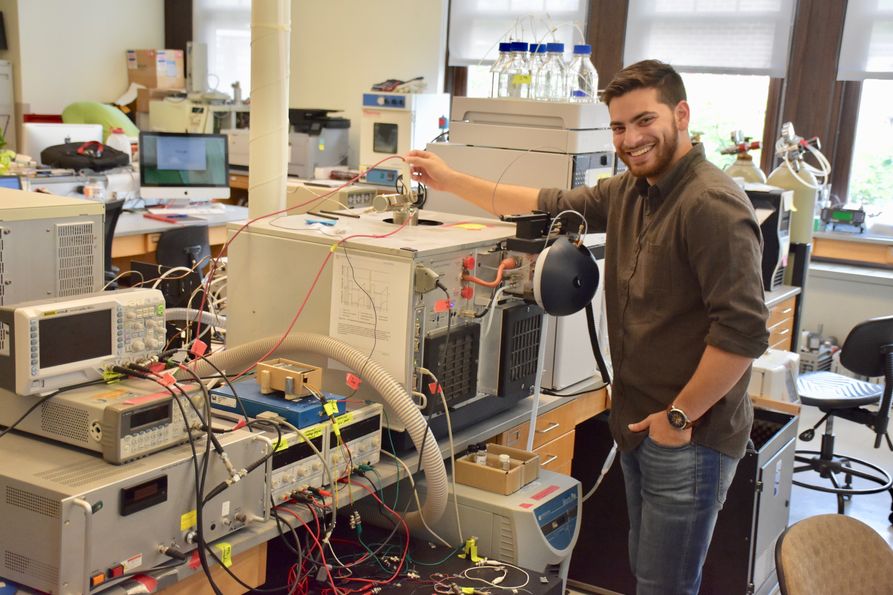Research
Outline
Our long-term goal is to catalyze the progress of biomedical, analytical and forensic research through the development of mass spectrometric instrumentation. More specifically, we develop fast chromatographic methods, new ion sources and new ways of performing tandem mass spectrometry. Once the capabilities of the new devices and methods are understood, controlled and optimized, selected applications are sought to demonstrate the benefits of the new instrumentation to the broader scientific community. Click on the projects below to learn more.- development of a new algorithm for mass spectral comparisons. The results are now published in a two-part manuscript in JASMS (Part 1; Part 2). Our presentation at SciX 2021 on the Expert Algorithm for Substance Identification (EASI) received the FACSS Innovation Award.
-
new ways of fragmenting gas-phase bio-ions, including peptides and oligosaccharides,
in tandem mass spectrometers using kiloelectronvolt helium ions. We use the term
charge transfer dissociation (CTD-MS) to describe the mechanism of activation.
(example publication)
-
new forensic applications of isotope ratio mass spectrometry, including hair,
nails and blow flies.
(example publication)
- understanding the mass spectrometric fragmentation behavior of novel psychoactive substances (NPSs). (example publication)
- experimental and theoretical approaches to understand the evaporation of ignitable liquids at elevated temperatures (e.g. 200 °C). (example publication)
Research Projects
1) EXPERT ALGORITHM FOR SUBSTANCE IDENTIFICATION
This project is currently supported by NIJ grant number 15PNIJ-21-GG-04179-COAP.
The project is spearheaded by Alexandra Adeoye, a PhD student in Forensic Science.
The main goal is to solve one of the longest-standing problems in mass
spectrometry, which is how to accurately identify an organic substance from
its mass spectrum when a spectrum of the suspected substance has not been analyzed
contemporaneously on the same instrument. The algorithm will help
practitioners make inter-laboratory identifications of drugs with meaningful error
rates.
Students: Alex Adeoye (PhD), Alexander
Pfeffer (UG).
Funding source: DOJ NIJ
15PNIJ-21-GG-04179-COAP
(2022-2023)
2) CHARGE TRANSFER DISSOCIATION (CTD) FOR BIOLOGICAL MASS SPECTROMETRY
We have successfully developed new instruments for the fragmentation of gas-phase biological ions, including metastable atom-activated dissociation (MAD) and charge transfer dissociation (CTD). CTD relies on the exothermic transfer of a charge from a helium cation to a biological gas-phase cation, with subsequent fragmentation of the newly-oxidized biological ion. The unique manner of energy transfer makes CTD is currently applied to oligosaccharides, where CTD efficiencies up to 40% are possible.For anyone wishing to implement CTD, we provide
all the details necessary to implement CTD on Bruker amaZon 3D ion trap in
a
shopping list, with schematics. The total cost of all the required parts,
power supplies, cables and oscilloscope is
<$15K. (not including the actual instrument, of course). Feel
free to contact Dr. Jackson for help setting up your own CTD system.
Students: Emily Ruiz (PhD), Madeline
Schuch (PhD), Courtney LaPointe (PhD).
Funding source: NIH 1R01GM114494-01 (PI Stephen Valentine, WVU) &
NSF CHE 1710376 (2018-2021)

3) NEW FORENSIC APPLICATIONS FOR ISOTOPE RATIO MASS SPECTROMETRY (IRMS)
Compound specific isotope analysis (CSIA) can provide unique insights into the sources of materials of forensic interest. For example, CSIA can be used to trace the origins of cocaine to within specific growing regions in South America, or to determine the common sources of high explosives. We use our limited-edition LC-IRMS to determine CSIA values of amino acids in proteinaceous materials like hair, human tissues, decomposing animals, blow flies (see picture below) and oysters. We are currently using the instrument to establish investigative leads from human hair.
Students: Erica Maney (PhD), Sarah Mosinski (UG).
Funding source: DOJ NIJ 2013-DN-BX-K007 (2013-2016)
4) STRUCTURAL CHARACTERIZATION OF EMERGING SYNTHETIC DRUGS
This project is currently driven by Erica Many and McKenna Oaks. The long-term goal is to help practitioners understand the mass spectra of existing and emerging novel psychoactive substances.
Funding source: DOJ NIJ 2018-75-CX-033 (2019-2021)
5) MATHEMATICAL MODELS FOR THE EVAPORATION (WEATHERING) AND IDENTIFICATION OF IGNITABLE LIQUIDS IN FIRE DEBRIS
This project was also funded by NIJ in September 2018. The project, which is a collaboration with Profs. Ruth Smith and Victoria McGuffin at Michigan State University, will help practitioners understand the detailed chemical relationships between fresh gasoline and the weathered residues found in fire debris. We are developing a mathematical model to explain the differences in evaporation rates for different components at different temperatures. Unlike previous studies, our model can predict more precisely the composition of residues at elevated temperatures (e.g. >200 °C). Example publication.
Students: Hannah McMillen (MS), Chaney Ganninger (MS)
Funding source: DOJ NIJ 2018-DU-BX-0225 (2019-2020)